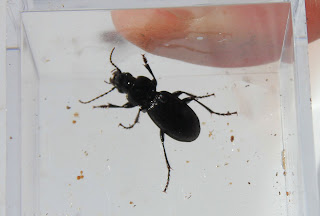
Glorious weather was met with a super turnout, one of the best I can recall for a FoCM event.
The numbers were boosted thanks to the joining of a group of MAD walkers, who tagged on as part of their programme.
Richard and I had chosen a variety of habitats and techniques to try. Indeed, when planning the walk, it was apparent that within not much more than a stone’s throw you could step from meadow, to scrub, to woodland and wetland habitat, all of which have their particular specialist ‘minibeasts’ in residence.
Our first challenge was to survey the ground level dwellers of grassland and scrub, our choice of location the old orchard by Jackson’s Boat Bridge, now well broken into and pedestrianised with footpaths.
A few days earlier we’d secreted around the orchard a few pit traps. These are fairly simple devices, comprising two plastic cups, the kind found on any water cooler, sunk into the ground. The reason for two is so that the inner cup can be removed from the ground smoothly without caving in the hole, which can then be reused for any longer term survey. We poured into each cup a small amount of an alcohol solution so as to quickly drown any fallers-in. Though seeming sound unkind, there is a sound reason for doing this, as in order to get a representative sample it is necessary to quickly stun or kill what happens to fall in. Without this, it is likely that all you’d be left with in the trap would be one fairly fat ground beetle: the top insect predator of the undergrowth, who would have happily fed on any lesser equipped species. Not that it was necessary as the days leading up to the walk were all very sunny, but we placed a piece of plexiglas over the top of the trap, secured into place with tent pegs and tilted at a angle to drain away any rain water from flooding the cup.
We quickly found all 6 traps hidden around the orchard and tipped out their contents into white plastic trays to better observe what we’d caught. All the traps contained some specimens, with most a spattering of small-sized representatives from the arachnids and springtails – two of the more common families which play an important dietary component to larger species. Equally enjoyable during this was the joining of our group of two or three unexpected insect guests, namely a common grasshopper and froghopper, both obligingly seated onto people’s coats, and in the case of the froghopper, onto the rim of the tray, making them easy to be caught in viewing pots.
One of the more impressive specimens, and something we’d hoped to catch, was a species of large ground beetle. The ground beetles are a numerous family, possibly containing many hundreds of species, their individual types only often separated through close observation of such things as the number hairs on their legs. One notable feature of the two we found is that they were all black, including their legs. Other species I’m familiar with, often from turning over logs or old carpet!, exhibit violet or black colourations to their legs or flanks – so, if anyone has any more exact information on the all black species we caught, please let us know.
The next stopping off point was the boggy drainage channel which connects the Mersey to Sale Water Park. This slow moving water is often left undisturbed, the sluice gates connecting it to the Mersey only rarely opened when the water levels get particularly high. As consequence, it’s a rich habitat for many invertebrates. Some of the star groups are the damsel and dragon flies that live out their lifecycles here – and sure enough, we observed in the reeds and grass around the channel a few examples of damsel flies, one of the most attractive a male banded demoiselle, replete with it dark thumb print on its wings.

We then took some scoops out of the channel using pond nets and tipped the contents into our trays. This is always an exciting process as it’s not everyday you come into contact with the invertebrate life of ponds, and when you do I’m always struck by the impressive size and alien shapes that thrive. Species which were observed ranged from leeches, molluscs, including a small fresh waster muscle, pond skaters and water boatmen. However, the best capture was arguably a large, silvery species of diving beetle – seen up close fierce and otherworldly looking.

We rounded off the walk with an exploration of the woodland habitat close to the visitor’s centre at Sale Water Park. Here we all got involved by turning over logs and seeing what we could see living among the dead wood. Slugs were particularly common, with one particularly large example of a leopard slug being particularly impressive. We also found woodlice, lots or millipedes and beetles, all of which play an important role in the breaking down and recycling organic material back into the soil.
Julian Robinson






